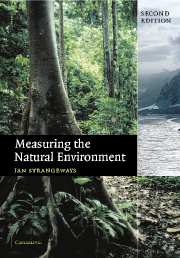Book contents
- Frontmatter
- Contents
- Acknowledgements
- 1 Basics
- 2 Radiation
- 3 Temperature
- 4 Humidity
- 5 Wind
- 6 Barometric pressure
- 7 Evaporation
- 8 Precipitation
- 9 Soil moisture and groundwater
- 10 Rivers and lakes
- 11 Data logging
- 12 Telemetry
- 13 Visibility
- 14 Clouds
- 15 Lightning
- 16 The upper atmosphere
- 17 The oceans
- 18 Cold regions
- 19 Remote sensing
- 20 Atmospheric composition
- 21 Forward look
- Appendix: abbreviations and acronyms
- Index
- References
7 - Evaporation
Published online by Cambridge University Press: 05 July 2014
- Frontmatter
- Contents
- Acknowledgements
- 1 Basics
- 2 Radiation
- 3 Temperature
- 4 Humidity
- 5 Wind
- 6 Barometric pressure
- 7 Evaporation
- 8 Precipitation
- 9 Soil moisture and groundwater
- 10 Rivers and lakes
- 11 Data logging
- 12 Telemetry
- 13 Visibility
- 14 Clouds
- 15 Lightning
- 16 The upper atmosphere
- 17 The oceans
- 18 Cold regions
- 19 Remote sensing
- 20 Atmospheric composition
- 21 Forward look
- Appendix: abbreviations and acronyms
- Index
- References
Summary
In the evening it rained very heavily, and although the thermometer stood at 65 °(F), I felt very cold. As soon as the rain ceased, it was curious to observe the extraordinary evaporation which commenced over the whole extent of the forest. To the height of 100 feet the hills were buried in a dense white vapour, which rose like columns of smoke from the most thickly wooded parts, especially the valleys. I observed this phenomenon on several occasions. I suppose it is owing to the large surface of foliage, previously heated by the sun's rays.
Charles Darwin Voyage of the Beagle (Rio de Janeiro).The variable
The rate of evaporation from the ground's surface and from plants is controlled by the relative humidity and temperature of the air, the amount of net radiation, the wind speed at the surface, the amount of water available and the nature of the surface (for example its roughness). The type of vegetation and the state of the plant's stomata are also involved since transpiration is generally lumped in together with evaporation. To allow for this, the ungainly word evapotranspiration has been coined; many do not like it, but it comes in useful and acts as a reminder. Open water presents another situation, as do ice and snow. The net incoming solar energy is apportioned to the three fluxes — sensible, latent and soil heat, and to photosynthesis — according to the infinite variety and combination of circumstances.
- Type
- Chapter
- Information
- Measuring the Natural Environment , pp. 113 - 133Publisher: Cambridge University PressPrint publication year: 2003



